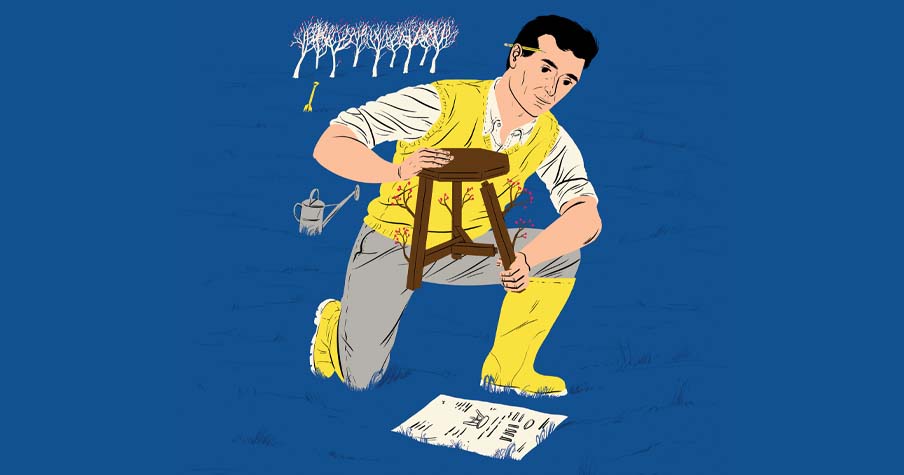
Illustration by Paul Blow
Planned giving provides theological schools a future. In Trust's Matt Hufman spoke with David Heetland, senior vice president of planned giving for Garrett-Evangelical Theological Seminary, to discuss legacy or planned giving. This is an edited version of their conversation. Heetland is a seasoned fundraiser, minister, and leader. His most recent books are: Happy Surprises: Help Others Discover the Joy of Giving and Creating Generous Congregations: A Step-by-Step Guide.
How would you define legacy giving, and why would you see it as important for a seminary or theological school?
Legacy giving is sometimes referred to as planned giving or giving through one’s estate when you pass away. I think it’s important for seminaries to have a legacy giving program because it gives a wonderful opportunity for donors to make a witness to their values. And that’s why I like the word legacy giving as well. It also gives seminaries a wonderful opportunity to receive some significant gifts.
What would you tell an institution that said: We’re just too busy to be doing legacy giving?
Many years ago, Harold Seymour wrote a book entitled Designs for Fund-raising. And in that book, he said that a well-designed fundraising program is like a three-legged stool. The three legs of fundraising are annual giving, capital giving, and planned gifts. And then he went on to say, if you don’t have all three legs in place, you have a very wobbly stool, and you have an incomplete fundraising program and are missing opportunities for major gifts. So I would echo that again, and I would say, yes, you really are missing a tremendous opportunity. And if you’re too busy to focus on that, then you’re too busy.
What do you see as the potential for legacy giving in terms of revenue for a school? Is there a percentage or a number that you like to think of?
The potential is tremendous. Some research suggests that the average legacy gift is anywhere between 200 to 300 times larger than an individual’s largest annual gift. Now, we know that most annual gifts come from a person’s annual income. Legacy gifts on the other hand are made from one’s accumulated assets when they no longer need them. Oftentimes a legacy gift is the largest gift that a person will ever make. Just one example: At Garrett, we have received more than $1 million in legacy gifts in each of the last three years, which is indeed an important percentage.
In fact, I’ve just checked it recently, and our legacy gifts have been anywhere from 20 to 37% of our overall gifts for the year. The average matured planned gift is actually over $65,000.
What it requires is planting the seed again and again and again because people’s lives change, circumstances change.
One of the objections to planned giving is that you can’t “book” a legacy gift until it comes in. A school might not see it for years, and maybe not at all if a will changes, so some schools may not see it as important. How would you respond to that kind of discussion?
It’s true that it may not come in for decades, but if you are committed to intergenerational stewardship, then you want to cultivate gifts, both for the short term and the long term. And hopefully every school keeps track of those who have shared that they have included the school in a planned gift or a legacy commitment, and we should find ways to thank them for that. Perhaps inviting them into a recognition society, which says to them, we value such gifts. It also hopefully encourages others to do likewise. And yes, certainly someone can remove an institution from their will. Wills can change. But what I’ve discovered is that if we nurture those planned gift commitments and if we steward those relationships, the change is oftentimes to our benefit. In other words, donors will increase rather than decrease or remove the seminary from their will if we stay connected to them and if we help them understand the tremendous role their legacy gift can play in assisting the seminary to fulfill its mission.
There is a lot that goes along with developing a planned giving program – it takes time and effort. Would you say it’s worth it?
Yes, it does take some time and effort to bring legacy gifts to completion. And that’s why I think it’s very important to make sure that someone on the team can stay on top of planned gift commitments and who can also monitor the legacy gifts that have matured. I find that I need to spend a fair amount of time working with family members, attorneys, and executors of the estate to make sure that the donor’s wishes are carried out in a timely matter. And when I reflected on it, I realized that some of our largest estate gifts have indeed been gifts of farmland, homes, and stock. And yes, they took time to bring to completion. But in the end, I thought it was a joy to receive them.
Are there certain types of givers you’re looking for when you’re looking at legacy gifts or planned giving?
Yes. The persons that I would be looking for are long-term donors, and, as well, those who are closest to the seminary, such as faculty, staff, trustees, and alums because these are often the best planned-giving prospects. When the pandemic struck and made it impossible for me to visit donors personally, I pulled a list of those who had been regular donors for 20 years or more, and I picked up the phone and started calling them. I would thank them for their faithful support over the years, and then I would invite them to consider endowing their commitment, and believe it or not, I received several new commitments just doing that.
With a legacy gift, are there special things that you have to attend to? You mentioned attorneys, estate planners, and givers. But are there other things you have to attend to in the relationship to make that work?
I have a plaque in my office, which reads, “Fundraising is not really about money. It’s about people.” And that constantly reminds me to never ever take a legacy commitment for granted, but rather to continue to find ways to thank the donors for their commitment and to let them know how much we value their relationship. That includes remembering them on their birthdays and their anniversaries and other special occasions, just as you would any other important relationship. One of the things I did this morning was order flowers for a woman who is celebrating her 91st birthday this week and has a wonderful legacy commitment to the seminary.

Illustration by Paul Blow
In your book Happy Surprises, you talk about the importance of engaging with people and continuing to have relationships. How do you keep up with them?
We do have software that reminds me when people are having their birthdays and when they have made their last gift, and those two things give me opportunities to keep in touch with them. But I try to keep in touch with them in as many other ways as possible as well, such as through phone calls, and letters, and cards, and emails and personal visits. It’s a never-ending challenge, but it’s worth the time and the effort. And I think just to do whatever we can to say, these people are important, we need to keep those relationships alive.
What would you tell a board member if they came and said, ‘David, what do I need to know about planned or legacy giving?’
Well, I think I would tell that person just what I stated at the beginning, that legacy giving is an important part of the fundraising stool and that we need to have an active fundraising program. And then I would say to the trustee that just as you are expected to set the pace and lead the way with annual gifts and capital gifts, I hope and pray that you will also lead the way with a legacy gift. And I would also say to the trustee, if they don’t have a program in place already, don’t expect immediate results. The board should make a long-term commitment to planned giving.
It does not take a lot of money or a lot of programming. What it requires is planting that seed again and again and again because people’s lives change, circumstances change. And when you invite someone to consider a planned gift at one point, they may not be ready for that conversation. But as time goes on and circumstances change, they may be very open to that conversation. So, I heard one time and I believe it’s true, that if a board was to commit to a planned giving program, they should commit to at least three years before they could begin to perhaps expect any results.
What else would you want people to know about planned or legacy giving?
Well, just a reminder that there’s going to be a tremendous transfer of wealth in the years ahead as Baby Boomers begin to pass away. In fact, I read recently that over the next 25 years, Baby Boomers will pass an estimated $30 to $60 trillion on to the next generation. We also know there’s going to be tremendous competition for those dollars from countless charities. And I would simply say to folks: You will be doing your school and your donors a tremendous favor if you have an active legacy program and say to donors: Here’s a wonderful way for you to leave a legacy that reflects your values, and it’s a wonderful way for the seminary to make sure that it has resources, not just for the immediate future, but for the long-term future.
To view a video of the full conversation, click here.